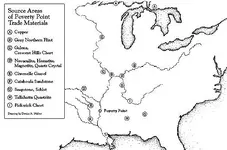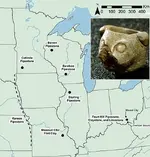- #261
Thread Owner
Some curiosity is all Mdog. I've little else to offer this morning.
Some distribution mentioned in this article. Few answers. A question though might be , did the Hopewell culture come up with the figures they did on their own? Or were they influenced by another/other culture.
They seem to have been exposed to others through trade/distribution.
As they would any signs created by others .
I don't buy the shaman use of pipes to create a trance. Though I don't know what shamans did thousands of years ago...
Pipes more recently and by some were sanctified. As ceremonial items should be. Pipe bags were not uncommon. Maybe telling in their decoration of more than being just a pipe bag.
Etiquette (depending on nation/tribe) dictated how a pipe for ceremony (and folks just plain smoked too in less elaborate pipes) was filled . How it was lit. How it was held to pass. Direction it was passed. Where it's ashes went after , ect.. Importance was there. A process far from casual , so it can be expected that a pipes form was as well. Beyond just being neat to look at.
Why an Owl figure for a pipe?
Could it have been to represent a clan? Or simply an Owl? A particular spirit that the maker encountered? Or other inspiration?
Enigmatic 2,000 -Years-Old Carved Stone Owl Pipes ? An Ancient Unsolved Secret Of Illinois | Ancient Pages
Thanks for the link, RC.
So far, the oldest mound group found in the USA is at Watson Brake in north east Louisiana. The mounds there have been dated to about 3500 BC. So the Hopewell cultures, of 100 BC to 500 AD, would have had over 3000 years of influence from older Mound Builder cultures. As for the carved stone owls, the earliest examples that I've seen, are the small squat red stone owls of Poverty Point, 1700-1100 BC. Why the owl? I can only guess, like everybody else. The owl is kind of a mysterious animal and probably used by the spiritual leaders to scare the hell out of people. Kinda like how they used the snake. That might be why the owl is associated with shamen and witches. I've posted that the little owl beads, from Poverty Point, might have been some type of Old World influence left by traders who were mining copper in the Great Lakes region. As far as I know, Poverty Point was the first site that showed evidence of large ceremonial posts. Large wooden posts were used to represent ancient gods in the Middle East. Something else that might show an Old World influence are clay figurines of headless pregnant women. These figurines are also absent legs and arms.
https://www.crt.state.la.us/dataprojects/archaeology/povertypoint/ceremonial-life.html
Something else that shows on your link, the two mounds mentioned were real close to the Ohio River and there is evidence that Poverty Point collected grey northern flint very close to those two mounds.


I think the old shamen might have had some real good dope.
" Tobacco smoked by Native peoples had much more potent amounts of nicotine and could lead to hallucinations and altered states of consciousness, thus giving these individuals access to the “Above World.” However, due to geographical barriers and lack of access, modern American Indian descendants have never before weighed in on these speculative uses for the Adena Pipe."
http://www.ohiohistorycentral.org/w/Adena_Pipe
Here is a link showing part of Father Marquette's journal where he speaks of the sacred pipe.
SECTION 6TH
Last edited:







